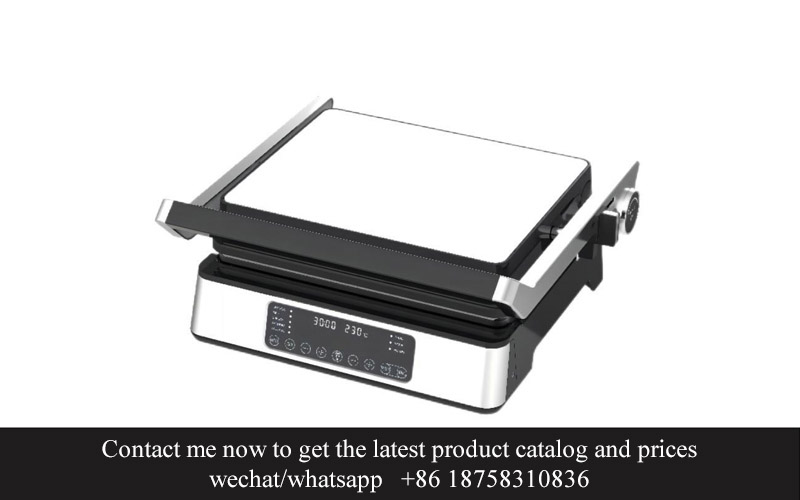Address
304 North Cardinal
St. Dorchester Center, MA 02124
Work Hours
Monday to Friday: 7AM - 7PM
Weekend: 10AM - 5PM
Address
304 North Cardinal
St. Dorchester Center, MA 02124
Work Hours
Monday to Friday: 7AM - 7PM
Weekend: 10AM - 5PM

In a world where technology intertwines with everyday life, the kitchen has become a canvas for innovation. As the heart of the home, it’s witnessing a remarkable transformation with the advent of smart kitchen appliances. These devices, powered by sophisticated integrated circuit boards (ICBs), are reshaping how we interact with our culinary environments. The story of these ICBs is one of relentless pursuit, cutting-edge technology, and the ever-evolving needs of consumers. This narrative delves into the intricate world of ICBs in kitchen appliances, exploring their impact, challenges, and the future landscape of this dynamic industry.
In the heart of the culinary revolution, kitchen appliances are undergoing a dramatic transformation, powered by the precision and ingenuity of integrated circuit board (ICB) factories. These factories are the silent architects behind the smart kitchen appliances that are reshaping how we interact with our cooking spaces. Let’s delve into the innovations that are setting the stage for the next era of kitchen technology.
The integration of smart features into everyday kitchen appliances has become more than a trend—it’s a necessity. From ovens to refrigerators, ICBs are the unsung heroes that enable these devices to learn, adapt, and improve our lives. These tiny circuits are the backbone of smart kitchens, where every function from temperature control to automated meal preparation is meticulously managed by these intricate boards.
Within the walls of modern ICB factories, cutting-edge technology meets meticulous craftsmanship. The process begins with a blend of raw materials that, when combined, form the foundation of complex circuitry. Each layer is carefully laid out, with precision that can only be achieved through advanced machinery and skilled technicians. The result is a board that not only fits the physical space of the appliance but also the digital demands of the consumer.
One of the most significant innovations in ICBs is the integration of microcontrollers that can process and respond to a multitude of signals. These microcontrollers are the brain behind the smart functionality, enabling appliances to connect to the internet, communicate with other devices, and even learn from user habits. The ability to adjust cooking times and temperatures based on individual preferences is now a reality, all thanks to these tiny yet powerful circuits.
Consumers are not just looking for smart features; they’re expecting seamless integration and intuitive control. ICB factories have responded by creating circuits that are not only efficient but also user-friendly. Touchscreens and voice control systems, made possible by ICBs, have replaced the need for complex interfaces, making kitchen appliances accessible to all users, regardless of technical expertise.
Market trends are also driving innovation in ICB factories. As consumers demand more energy-efficient appliances, these factories are pushing the boundaries of circuit design to reduce power consumption without compromising performance. Advanced materials and design techniques are being employed to ensure that appliances remain cool and operate optimally, even during intense cooking sessions.
The rise of connected homes has also fueled the need for ICBs that can support multiple devices and systems. Smart kitchens are no longer isolated islands of technology; they are part of a larger ecosystem where appliances can collaborate and share information. This interconnectedness is made possible by ICBs that are designed with compatibility and scalability in mind.
However, with great innovation comes its own set of challenges. Ensuring the security and privacy of data transmitted through smart appliances is a top priority for ICB factories. Implementing robust encryption and secure communication protocols is crucial to maintain consumer trust and protect against potential threats.
Innovation in ICB factories is not just about creating new features; it’s about anticipating future needs. The industry is on the brink of a new era where appliances will not only perform tasks but also provide valuable insights into our health and lifestyle choices. ICBs are being designed with the flexibility to accommodate these advancements, ensuring that kitchen appliances remain relevant and useful as consumer habits evolve.
Case studies of leading ICB factories show a commitment to sustainability and ethical manufacturing practices. These factories are not only focused on the quality and functionality of their products but also on the environmental impact of their processes. By using recycled materials and reducing waste, these factories are setting a precedent for the industry as a whole.
In conclusion, the role of ICB factories in revolutionizing the kitchen is undeniable. Their innovations are at the forefront of a culinary revolution, where appliances are becoming more intelligent, efficient, and connected than ever before. As these factories continue to push the boundaries of technology, the kitchen of the future is not just a promise—it’s a tangible reality.

In recent years, the kitchen has undergone a remarkable transformation, evolving from a mere space for cooking to a hub of innovation and convenience. The advent of smart kitchen appliances has revolutionized the way we interact with our daily culinary routines, offering a blend of technology and functionality that has redefined modern living.
The integration of smart technology in kitchen appliances has made everyday tasks more efficient and enjoyable. From automated ovens that adjust cooking times based on the food’s properties to refrigerators that can track and manage your grocery list, the smart kitchen is a testament to how far we’ve come in harnessing the power of technology for domestic purposes.
Smart kitchen appliances are not just about convenience; they’re also about health and wellness. Smart scales and fitness trackers that sync with your kitchen appliances can help you monitor your dietary intake and exercise habits, ensuring a more balanced lifestyle. These devices often come with user-friendly interfaces, allowing for easy data analysis and personalized recommendations.
The rise of the connected kitchen is fueled by the increasing availability of high-speed internet and the proliferation of smart devices. Smart cookers, blenders, and toasters can now be controlled remotely through smartphones, offering users the flexibility to manage their kitchen from anywhere. This connectivity has also given rise to the concept of the “Internet of Things” (IoT), where appliances can communicate with each other to create a seamless and integrated cooking experience.
The design of smart kitchen appliances has also seen a shift, moving away from bulky, clunky units to sleek, stylish pieces that complement modern interior design. Companies are focusing on creating appliances that are as visually appealing as they are functional, appealing to the aesthetic sensibilities of today’s consumers.
Innovation in the realm of integrated circuit (IC) technology has been a driving force behind the smart kitchen revolution. Advanced ICs are now capable of processing vast amounts of data, allowing for complex algorithms that can optimize cooking times, temperatures, and even flavor profiles. This has led to appliances that can not only perform tasks with precision but also adapt to the user’s preferences over time.
The user experience has also been enhanced by the inclusion of voice-activated controls, which have become increasingly common in smart kitchen appliances. Users can now issue commands to their appliances using simple voice commands, thanks to advancements in artificial intelligence and natural language processing.
Moreover, the energy efficiency of smart kitchen appliances has improved significantly. With features like energy-saving modes and smart energy monitoring, these devices can help reduce utility bills while still providing all the functionality needed for a modern kitchen.
Security is another crucial aspect that has been addressed with the introduction of smart kitchen appliances. With the ability to monitor and control appliances remotely, users can ensure their kitchen is secure even when they’re not at home. Features like facial recognition and biometric authentication add an extra layer of protection against unauthorized access.
Despite the many benefits, there are challenges to be addressed. Privacy concerns, data security, and the potential for cyber threats are all areas that need careful consideration as the kitchen becomes more connected. Manufacturers and developers are working to ensure that the benefits of smart kitchen appliances are balanced with robust security measures.
In conclusion, the rise of smart kitchen appliances is a testament to the incredible pace at which technology is advancing. These innovations are not just making cooking easier and more efficient; they are also enhancing our overall quality of life. As we continue to see advancements in integrated circuit technology and other related fields, the future of the kitchen promises to be even more exciting and interconnected than ever before.

In the ever-evolving landscape of kitchen appliances, integrated circuit board (ICB) factories play a pivotal role in driving innovation and efficiency. These factories are the unsung heroes behind the sleek, smart kitchen gadgets that have become an integral part of modern households.
The heart of every smart kitchen appliance is the integrated circuit board, a tiny yet powerful component that orchestrates the device’s functions. These factories, often hidden from the consumer’s eye, are the precision-engineered workshops where these intricate boards are born.
These factories are hubs of advanced technology, employing state-of-the-art manufacturing processes to ensure the highest quality of ICBs. From the initial design phase to the final assembly, every step is meticulously controlled to prevent errors and ensure reliability.
The manufacturing process begins with the sourcing of raw materials, which must meet stringent quality standards. Components like silicon, copper, and gold are carefully selected and processed to create the conductive pathways that will power the appliance’s functions.
Once the materials are prepared, they are laid out on a wafer, a thin slice of silicon that serves as the foundation for the ICB. The wafer then undergoes a series of chemical and physical transformations, including doping and etching, to create the intricate patterns necessary for the circuitry.
Next comes the photolithography process, where a light-sensitive chemical is applied to the wafer. A mask is then placed over the wafer, and light is shone through it, hardening the exposed areas. This creates a negative image of the circuit pattern on the wafer, which is then etched away in the non-hardened areas.
After the pattern is etched, the wafer is subjected to a series of chemical baths and cleanings to remove any impurities. This is followed by the deposition of insulating layers, which protect the delicate circuits from electrical shorts and physical damage.
The wafer then moves through a series of testing stations, where it is checked for defects and functionality. Only the wafers that pass these rigorous tests are deemed fit for use in kitchen appliances.
The next step is the packaging of the individual ICBs. These tiny circuits are encased in protective materials, often plastic or ceramic, to shield them from the environment and ensure they can withstand the heat and humidity of a kitchen setting.
Once the ICBs are packaged, they are shipped to the appliance manufacturers, who integrate them into their products. The precision and reliability of these ICBs are crucial, as they often control critical functions such as temperature regulation, sensor readings, and user interface operations.
In addition to the manufacturing process, ICB factories also focus on research and development. They work closely with appliance designers to develop new technologies that can push the boundaries of what’s possible in kitchen appliances. This includes everything from energy-efficient circuits to advanced AI capabilities that can learn and adapt to a user’s habits.
The role of ICB factories extends beyond just manufacturing; they are also at the forefront of sustainability efforts. As the demand for smart kitchen appliances continues to grow, these factories are under pressure to find ways to produce more efficiently and with less environmental impact. This includes using renewable energy sources, reducing waste, and developing materials that are recyclable or biodegradable.
In conclusion, the role of ICB factories in the kitchen appliance industry is multifaceted. They are not just the creators of the tiny, powerful components that make smart appliances possible; they are also the innovators, the researchers, and the sustainability champions. Their work is crucial in shaping the future of the kitchen, making it smarter, more efficient, and more personalized for each user.

In the realm of technology, integrated circuit boards (ICBs) are the unsung heroes, the backbone of countless devices, and the driving force behind the smart kitchen revolution. These tiny marvels of engineering have seen a surge in innovation, pushing the boundaries of what’s possible in kitchen appliances.
The miniaturization of components has been a game-changer, with ICBs now packing more power and functionality into smaller spaces. This has allowed for sleeker, more efficient appliances that don’t compromise on performance. For instance, the latest ICBs can integrate multiple functions like touch controls, voice activation, and energy-saving modes, all within a compact design.
One of the most significant innovations is the advent of multi-core processors in ICBs. These processors enable appliances to handle complex tasks simultaneously, such as monitoring temperature, adjusting cooking modes, and providing real-time feedback. This not only enhances the user experience but also ensures that the appliance operates at peak efficiency.
Energy efficiency is another area where ICBs have made remarkable strides. Advanced power management techniques on these boards have reduced energy consumption without sacrificing performance. This is particularly crucial in kitchen appliances, where energy costs can add up over time. Smart ICBs can optimize energy use by adjusting to the cooking requirements, thus saving both money and resources.
The integration of wireless connectivity has been a pivotal innovation in ICBs. With the ability to connect to the internet and other devices, kitchen appliances can now be part of a larger smart home ecosystem. This means users can control their appliances remotely, receive notifications about usage patterns, and even update firmware for improved functionality. The ICBs that power these devices are equipped with robust security features to protect against hacking and unauthorized access.
In terms of material science, there has been a shift towards using more durable and heat-resistant materials in ICBs. This is essential for kitchen environments where appliances are subject to varying temperatures and conditions. The use of advanced materials like gallium nitride (GaN) and silicon carbide (SiC) has not only improved the longevity of ICBs but also allowed for higher power densities and faster switching speeds.
Customization is another area where ICBs are leading the charge. Manufacturers are now able to design ICBs that are tailored to specific appliance needs. This means that each kitchen appliance can have a unique set of features and capabilities, all thanks to the flexibility of modern ICB technology. For example, a high-end oven might have an ICB designed to handle the precision required for intricate cooking modes, while a basic countertop appliance might have a more straightforward, yet efficient, board.
The rise of AI and machine learning has also had a profound impact on ICBs. These smart circuits can now learn from usage patterns, adapt to user preferences, and even predict maintenance needs. This level of intelligence not only makes appliances more user-friendly but also extends their lifespan by preventing potential issues before they arise.
Moreover, the environmental impact of ICBs has not been overlooked. With the growing concern over electronic waste, there is a push to design ICBs that are more recyclable and have a lower carbon footprint. This includes using eco-friendly materials and designing circuits that are easier to disassemble and recycle at the end of their life.
In conclusion, the innovations in ICBs are reshaping the landscape of kitchen appliances. From improved efficiency and functionality to enhanced connectivity and environmental responsibility, these advancements are making kitchen appliances smarter, more intuitive, and more sustainable. As technology continues to evolve, the possibilities for what ICBs can achieve in the kitchen are virtually limitless.

In the realm of kitchen appliances, the integration of cutting-edge integrated circuit boards (ICBs) has significantly transformed the consumer experience. This evolution has brought about a myriad of benefits that enhance convenience, efficiency, and enjoyment in the kitchen. Let’s delve into how these advancements have reshaped the way we interact with our appliances.
The Precision of Smart CookingModern ICBs have enabled kitchen appliances to offer precise control over cooking processes. From ovens that maintain consistent temperatures to microwaves that defrost with accuracy, these advancements have eliminated the guesswork often associated with traditional cooking methods. Consumers now enjoy meals that are cooked to perfection, every time.
Customization at Your FingertipsWith the help of ICBs, kitchen appliances have become more customizable than ever before. Smart ovens, for instance, can be programmed with specific recipes, while refrigerators can adjust their cooling settings based on the type of food stored inside. This level of personalization ensures that each appliance caters to the unique needs and preferences of its user, creating a more tailored and satisfying cooking experience.
Enhanced Connectivity and ControlThe integration of ICBs has also led to greater connectivity within the kitchen. Smart devices can now be controlled remotely through smartphones or voice assistants, allowing consumers to manage their appliances even when they’re not at home. This connectivity not only adds convenience but also provides peace of mind, knowing that the kitchen is always under control.
Safety and Peace of MindSafety is a paramount concern in the kitchen, and ICBs have played a crucial role in enhancing it. Appliances equipped with these boards can detect and prevent overcooking, overheating, and other potential hazards. Features like automatic shut-offs and smart alerts have become standard, reducing the risk of accidents and providing consumers with a sense of security.
Interactive Learning and AdaptationICBs have the capability to learn from user habits and adapt accordingly. Smart appliances can remember cooking preferences, suggest recipes based on the ingredients available, and even optimize their performance over time. This level of intelligence not only makes cooking easier but also empowers users to explore new recipes and cooking techniques with greater ease.
Aesthetic and Design ImprovementsThe integration of ICBs has not only improved functionality but also the aesthetic appeal of kitchen appliances. Modern appliances are sleeker, more compact, and often come with touchscreens and intuitive interfaces. This design evolution not only complements the kitchen’s decor but also makes the appliances more user-friendly and visually appealing.
Environmental ConsciousnessICBs have also contributed to the development of more environmentally friendly kitchen appliances. Energy-efficient models can reduce electricity consumption, and some appliances can even be powered by renewable energy sources. Consumers who are conscious of their carbon footprint can make more sustainable choices, knowing that their appliances are designed with the environment in mind.
Accessibility and InclusivityThe advancements in ICB technology have also made kitchen appliances more accessible to a wider range of users. Features like voice control and simplified interfaces have made appliances easier to use for individuals with disabilities or those who may have difficulty navigating traditional controls. This inclusivity ensures that everyone can enjoy the benefits of smart kitchen appliances.
In conclusion, the impact of ICBs on consumer experience in the kitchen is profound. From precision cooking and customization to enhanced connectivity and safety, these innovations have redefined the way we interact with our appliances. As technology continues to evolve, we can expect even more sophisticated features that will further elevate the consumer experience in the heart of our homes.

The kitchen, once a space dominated by traditional appliances, has transformed into a hub of innovation and connectivity. This shift is not just about the aesthetics of the kitchen but also about the functionality and the overall experience it offers to consumers. Let’s delve into the evolving market trends and the preferences that are shaping the future of kitchen appliances.
Consumer preferences are increasingly leaning towards convenience and efficiency. Modern lifestyles demand appliances that not only save time but also provide a seamless cooking experience. Smart ovens, for instance, are not just about heating food; they offer programmable settings, precise temperature control, and even predictive cooking capabilities based on the ingredients and desired outcome.
Energy efficiency has become a major concern. As consumers become more environmentally conscious, they are seeking appliances that consume less energy without compromising performance. Advanced ICBs are at the forefront of this trend, enabling appliances to operate more efficiently and reduce energy waste. The integration of smart sensors and microcontrollers allows for optimal energy management, leading to significant savings on utility bills.
Customization is another key factor. Consumers are no longer satisfied with one-size-fits-all solutions. They want appliances that can be tailored to their specific needs and preferences. This is where ICBs play a crucial role, enabling the creation of modular appliances that can be upgraded or replaced with ease. For example, a smart refrigerator can be fitted with a custom ice maker or a built-in wine cooler, depending on the user’s taste.
Sustainability is a growing concern, and it’s influencing consumer choices. Appliances that are designed with the environment in mind, such as those made from recycled materials or those that have a longer lifespan, are becoming more popular. ICBs contribute to sustainability by reducing the complexity of appliances, which can lead to simpler manufacturing processes and fewer parts that need to be replaced.
Safety is paramount, especially in the kitchen, where accidents can happen. The latest ICBs are equipped with advanced safety features, such as leak detection in dishwashers, automatic shut-off in ovens, and child locks on microwaves. These features provide peace of mind to consumers, knowing that their appliances are designed with their safety in mind.
Health and wellness are also influencing consumer preferences. Smart appliances that can monitor and adjust cooking temperatures to ensure even cooking and nutrient retention are gaining traction. For example, a smart pressure cooker can be programmed to maintain a specific pressure and temperature for the perfect cooking time, preserving the nutritional value of the food.
The integration of smart technology is reshaping consumer expectations. Users now expect their kitchen appliances to be compatible with their smartphones and other smart devices. This interconnectedness allows for remote control, monitoring, and even predictive maintenance. With ICBs, appliances can learn from usage patterns and offer personalized recommendations, creating a more intuitive and responsive cooking environment.
Accessibility is another area where consumer preferences are changing. As the population ages, there’s a growing demand for appliances that are easy to use and adaptable to various physical abilities. ICBs enable the inclusion of features like voice control, touchless interfaces, and adjustable settings, making kitchen appliances more inclusive for everyone.
The rise of e-commerce has also played a role in shaping market trends. Consumers are now accustomed to browsing and purchasing appliances online, which means they are looking for detailed product information, user reviews, and a seamless purchasing process. ICBs facilitate this by enabling manufacturers to provide real-time data and updates on their products, enhancing the customer experience.
In conclusion, the market trends and consumer preferences in the kitchen appliance industry are evolving rapidly. The role of ICBs in this transformation is undeniable, as they enable the development of smarter, more efficient, and more personalized appliances that cater to the needs and desires of today’s consumers. From energy efficiency to health-conscious features, the future of the kitchen is being shaped by the innovations that ICBs bring to the forefront.

The integration of technology into everyday appliances has been a gradual but significant shift in modern living. When it comes to kitchen appliances, the role of integrated circuit boards (ICBs) is becoming increasingly pivotal. As we delve into the future, it’s fascinating to consider how these tiny, yet mighty, components will continue to shape the landscape of kitchen appliances.
Advancements in material science are paving the way for more durable and efficient ICBs. With the use of advanced materials like graphene and silicon carbide, we can expect ICBs that are not only more robust but also capable of handling higher power demands. This means kitchen appliances will not only be more reliable but also better equipped to handle the latest innovations in cooking technology.
The rise of connectivity is a driving force behind the future of ICBs in kitchen appliances. Smart kitchens are no longer a futuristic concept; they are becoming a reality in many homes. ICBs will play a crucial role in enabling appliances to communicate with each other, providing seamless integration and control. From smart fridges that can suggest meal plans based on inventory to ovens that can be remotely controlled via a smartphone, the interconnected kitchen will rely heavily on the capabilities of ICBs.
Energy efficiency is a growing concern, and ICBs are at the forefront of this movement. As appliances become more sophisticated, they also become more power-hungry. However, the latest ICBs are being designed with energy-saving features that reduce consumption without compromising performance. This means appliances can offer the latest features while also being environmentally friendly, appealing to consumers who are conscious of their carbon footprint.
Customization is another area where ICBs will play a key role. With the ability to process vast amounts of data, ICBs can tailor the performance of kitchen appliances to individual preferences. Imagine a stove that adjusts its cooking temperature based on the type of food being prepared or a microwave that can sense the food inside and optimize its cooking time. Such personalization would not be possible without the sophisticated processing power of ICBs.
Security is a major concern in the digital age, and kitchen appliances are no exception. ICBs will need to be equipped with advanced encryption and authentication technologies to protect against hacking and unauthorized access. As more appliances are connected to the internet, the need for robust security measures will become even more critical. The future of ICBs in kitchen appliances will include layers of security to ensure the safety of both the appliance and its users.
The Internet of Things (IoT) is set to expand its reach into the kitchen, and ICBs will be at the core of this expansion. Appliances that can learn from user habits, predict maintenance needs, and even order replacement parts automatically will rely on ICBs to process the necessary data. This interconnected network of kitchen appliances will not only streamline cooking processes but also create a more intuitive and responsive environment for the homeowner.
The trend towards sustainability will continue to influence the development of ICBs in kitchen appliances. As manufacturers strive to reduce the environmental impact of their products, they will look to ICBs that are easier to recycle and produce less waste during the manufacturing process. This includes the development of ICBs that are smaller, lighter, and use fewer materials, all while maintaining or improving their performance.
In conclusion, the future of ICBs in kitchen appliances is one of continuous improvement and adaptation. From enhancing connectivity and efficiency to ensuring security and sustainability, these tiny circuit boards will be at the heart of the next generation of smart kitchen appliances. As technology evolves, so too will the role of ICBs, ensuring that our kitchens remain at the forefront of innovation and convenience.

In the ever-evolving landscape of technology, the challenges and opportunities that arise are as diverse as they are complex. For integrated circuit board (ICB) factories, the world of kitchen appliances presents a unique set of hurdles and possibilities.
Navigating Complexity: The demand for more sophisticated and integrated circuits in kitchen appliances has increased the complexity of design and production. Engineers must balance intricate circuitry with the need for compact, efficient, and durable boards. This complexity can lead to longer development cycles and higher costs, but it also opens doors for innovation and specialization.
Energy Efficiency: As consumers become more environmentally conscious, there’s a growing preference for energy-efficient appliances. ICB factories face the challenge of creating circuits that not only save energy but also perform optimally. The opportunity here lies in developing new materials and technologies that can revolutionize the energy efficiency of kitchen appliances.
Customization: The rise of the internet of things (IoT) has spurred a demand for personalized appliances. While this presents a challenge in terms of creating flexible and adaptable ICBs, it also offers the chance to cater to niche markets and enhance customer satisfaction through tailored product offerings.
Material Science: The evolution of materials, such as gallium nitride (GaN) and silicon carbide (SiC), promises to transform the capabilities of ICBs. These materials can handle higher voltages and currents more efficiently than traditional silicon, leading to smaller, faster, and more durable circuits. The challenge is to integrate these materials into existing production processes and ensure compatibility with a wide range of appliances.
Globalization: The global nature of the appliance market means that ICB factories must consider international regulations, standards, and supply chain dynamics. While this can be a challenge due to the complexity of managing multiple jurisdictions, it also provides opportunities for collaboration and expansion into new markets.
Security Concerns: With the increasing connectivity of kitchen appliances, cybersecurity has become a paramount concern. ICB factories must address the challenge of embedding robust security measures into their products. This not only protects consumers but also opens up new markets for security-focused products.
Regulatory Compliance: Governments around the world are enacting stricter regulations on electronic waste and product safety. ICB factories must navigate these regulations to ensure their products meet environmental and safety standards. The opportunity here is to lead the industry in sustainable practices and set new benchmarks for product integrity.
Market Disruption: The entry of new players and the disruption of traditional business models can shake up the ICB factory sector. The challenge is to adapt to these changes and find new ways to differentiate products and services. The opportunity is to capitalize on market shifts by embracing digital transformation and leveraging data analytics to improve operations.
Technological Pace: Staying ahead of the technological curve is a constant challenge for ICB factories. They must invest in research and development to keep pace with rapid advancements. The opportunity is to become a leader in new technologies, setting the standard for the industry.
By addressing these challenges and capitalizing on these opportunities, ICB factories can not only survive but thrive in an industry that is rapidly evolving. The key is to remain agile, innovative, and customer-focused, ensuring that the products they create are not just functional but also forward-thinking and sustainable.

In the heart of the technological hub, there lies a beacon of innovation—a leading integrated circuit board (ICB) factory that has redefined the landscape of kitchen appliances. This factory, known for its cutting-edge capabilities and relentless pursuit of excellence, stands as a testament to the power of precision engineering and visionary design.
The factory’s state-of-the-art facilities are a blend of modern architecture and advanced machinery. As you walk through the gleaming hallways, the air is filled with the hum of machines and the soft whir of robotics. The walls are adorned with intricate blueprints and timelines, showcasing the meticulous planning that goes into each project.
The workforce is a diverse mix of engineers, technicians, and designers, all united by a common goal: to push the boundaries of what’s possible in kitchen appliances. Each team member brings a unique perspective, contributing to the factory’s dynamic and collaborative environment.
At the core of the factory’s operations is the production line, where the precision of human hands meets the efficiency of automated systems. The process begins with the sourcing of high-quality materials, carefully selected for their durability and reliability. These materials are then transformed into intricate ICBs through a series of meticulously controlled steps.
The factory prides itself on its ability to produce ICBs with unparalleled precision. The manufacturing process involves the use of laser-cutting technology, which allows for the creation of complex circuits with microscopic detail. Each ICB is then subjected to rigorous quality checks, ensuring that it meets the stringent standards set by the factory’s management.
One of the standout features of the factory is its commitment to sustainability. Energy-efficient lighting and advanced recycling systems are just a few of the eco-friendly practices in place. The factory also invests in renewable energy sources, aiming to reduce its carbon footprint and contribute to a greener future.
As you tour the factory, you’re greeted by the sight of engineers huddled over their workstations, deeply engrossed in their tasks. They are the architects of the next generation of kitchen appliances, using sophisticated software to design ICBs that are not only efficient but also adaptable to a variety of applications.
The factory’s R&D department is a hub of creativity and problem-solving. Here, engineers experiment with new materials and manufacturing techniques, constantly seeking ways to improve the performance and longevity of ICBs. They collaborate with academic institutions and industry partners to stay at the forefront of technological advancements.
One of the most impressive aspects of the factory is its dedication to training and development. The factory understands that the future of kitchen appliances lies in the hands of its workforce. As such, it invests heavily in employee training programs, ensuring that its staff are equipped with the latest skills and knowledge.
The factory’s partnerships with major appliance brands are a testament to its reputation for excellence. These collaborations result in the production of ICBs that are not only functional but also aesthetically pleasing. The factory’s commitment to aesthetics is evident in the sleek, modern designs of the ICBs, which are tailored to fit the latest kitchen trends.
As you make your way through the factory, you can’t help but notice the attention to detail. From the precision of the manufacturing process to the care taken in packaging the finished products, every aspect of the factory’s operations is a reflection of its commitment to quality.
In the heart of the factory, there’s a sense of purpose and passion. Employees take pride in their work, knowing that their contributions are shaping the future of kitchen appliances. The factory’s culture is one of innovation and continuous improvement, where every individual is valued and empowered to make a difference.
As the tour comes to a close, you’re left with a profound sense of awe. This leading ICB factory is more than just a place of production; it’s a symbol of human ingenuity and the endless possibilities that lie ahead in the world of kitchen appliances.

The integration of technology into everyday life has led to a transformative era in various industries, and the kitchen appliance sector is no exception. As we delve into the future, it’s clear that the role of integrated circuit boards (ICBs) will continue to expand, influencing the design, functionality, and user experience of kitchen appliances. Let’s reflect on the challenges and opportunities that lie ahead in this dynamic field.
The push for greater energy efficiency and sustainability presents a significant challenge for ICB manufacturers. As consumers become more environmentally conscious, there’s an increasing demand for appliances that consume less energy while maintaining their performance. This necessitates the development of more sophisticated ICBs that can optimize energy use without compromising on quality or durability.
Moreover, the rapid pace of technological advancements demands constant innovation. ICB factories must stay abreast of new materials, processes, and design techniques to keep up with the ever-growing list of features and functionalities expected in modern kitchen appliances. The challenge lies in balancing innovation with the need for reliability and cost-effectiveness.
On the flip side, the rise of the smart kitchen has opened up a world of opportunities. The ability to integrate ICBs with connectivity features like Wi-Fi and Bluetooth has paved the way for appliances that can be controlled remotely or through voice commands. This not only enhances convenience but also allows for greater personalization of cooking experiences.
Another opportunity lies in the realm of health and wellness. As people become more health-conscious, there’s a growing market for kitchen appliances that can help them prepare nutritious meals with minimal effort. ICBs can play a pivotal role in creating appliances that not only monitor and adjust cooking times and temperatures but also provide nutritional information and recipe suggestions.
The need for increased security in smart kitchen appliances is also a challenge that comes with opportunity. With more appliances connected to the internet, the risk of cyber threats grows. ICB factories must invest in developing secure, robust, and resilient circuits to protect consumer data and privacy. This not only ensures safety but can also be a selling point in a competitive market.
The customization of appliances is another trend that ICB factories can capitalize on. With advancements in ICB technology, it’s becoming easier to create appliances that can be tailored to individual preferences. This could range from programmable settings that adapt to user habits to appliances that can be upgraded with new features over time.
The rise of e-commerce and direct-to-consumer sales models has also changed the landscape for ICB factories. They now face the challenge of scaling up production quickly to meet demand while also ensuring product quality. The opportunity here is to establish partnerships with e-commerce platforms and develop supply chain strategies that can handle fluctuations in sales.
Lastly, the global supply chain disruptions have highlighted the importance of diversification. ICB factories that can adapt to sourcing materials from multiple regions are better positioned to mitigate risks associated with geopolitical tensions or natural disasters. This diversification not only strengthens the resilience of the industry but also allows for the exploration of new markets and business opportunities.
In conclusion, the challenges and opportunities in the ICB industry for kitchen appliances are multifaceted. From the push for sustainability and innovation to the need for security and customization, the future holds a blend of obstacles and chances for growth. By embracing these challenges and leveraging the opportunities, ICB factories can continue to drive the kitchen appliance industry forward, bringing more advanced, efficient, and user-friendly products to consumers around the world.